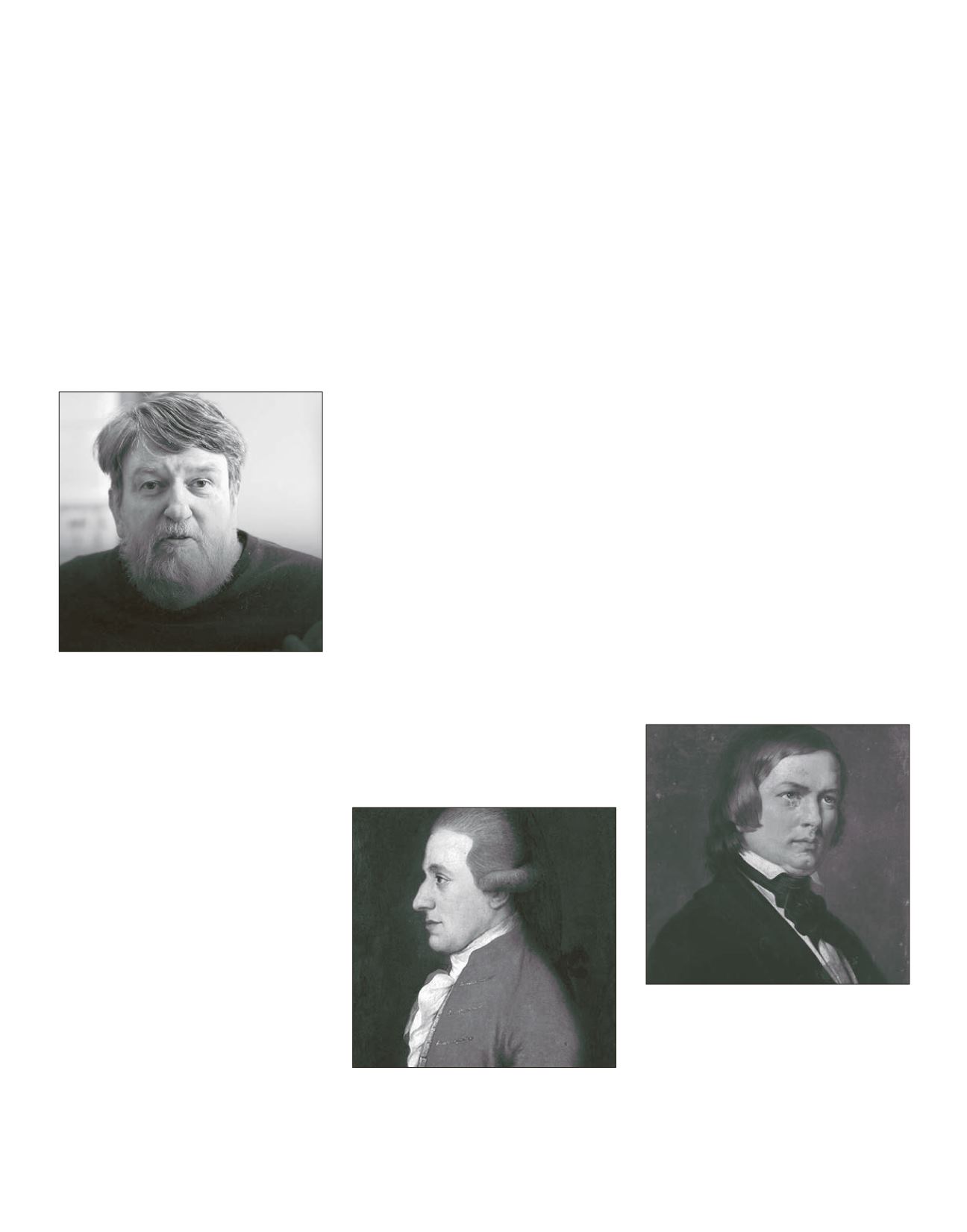
transformation occurs at several levels in this
score.
e theme itself contains an internal
variation, its rst six notes being manipulated
to produce the latter part. Knussen expanded
this material into variations grouped into
ve character variations, four passacaglia vari-
ations, and three etude variations.
is densely
integrated composition is characterized not by
austerity but by sumptuous piano sonorities.
WOLFGANG AMADEUS MOZART (1756-91)
Adagio in B minor, .
In addition to the keyboard sonatas and fan-
tasies, Mozart le a large body of autonomous
movements for the piano. Some of these are
the fragmentary remains of un nished sonatas.
Others were composed in a lighter, popular style
that would have appealed to the general pub-
lic and earned Mozart much-needed income,
a growing concern during the ve years before
his death. e Adagio in B minor, .
—com-
posed on March ,
—is a highly chromatic
work with the character of a fantasy.
Piano Sonata No. in B- at major, .
Two mysteries surround the .
sonata. First
is the occasion of its composition. According to
the dated manuscript, Mozart wrote the sonata
in February
, shortly before taking a round-
about tour of Germany. Little else can be stat-
ed with certainty. No commission has come to
light, and the score lacks a dedication. A second
question pertains to the correct instrumenta-
tion. Mozart, in his personal works catalogue,
called this “a sonata for solo piano.” However,
when Artaria published the rst edition in
a er Mozart’s death, a solo violin was added.
e duo tradition continued well into the th
century, but today deference is given to Mozart’s
piano sonata designation.
e Sonata No. in B- at major, .
, is writ-
ten in the same congenial vein as the Sonata
No.
in C major, .
, “für Anfänger” (for
beginners) and the nal “leichte” (easy) Sonata
No. in D major, .
, for Princess Friederike
of Prussia. An opening unison lends a re ned
manner to the
Allegro
. An abrupt modulation,
punctuated by four loud chords, prepares for
the lyrical second theme. Mozart develops the
themes in reverse order, leading them through
distant keys, then restores the sequence in the
recapitulation.
e
Adagio
spins long, symmetrical lines in its
refrain. A dreamy, minor-key melody is con-
structed of fragmented gestures.
e abridged
refrain is followed by a new theme in major, and
the refrain is stated a nal time. A spirited trio
of themes alternates in Mozart’s compact ron-
do nale.
e rst unfolds in several balanced
strains. A er a full stop, the syncopated con-
trasting melody is introduced. Chromatic two-
part writing characterizes the third theme.
e
original idea draws the sonata to a close.
ROBERT SCHUMANN (1810–56)
Waldszenen
, op.
Battling depression in
—no doubt a re-
sponse to Clara’s pregnancy, as Peter Ostwald
has suggested—Schumann thrust himself into
compositional work.
is concentrated activity
produced the nine-piece piano cycle
Waldszenen
(
Forest Scenes
) in nine short days, beginning on
December . His original conception matched
each piece with a poetic motto, employing
texts by Friedrich Hebbel and Heinrich Laube.
Schumann removed all but one inscription (on
No. , based on Hebbel’s poem “Die Blumen, so
hoch sie wachsen”) before publication.
Waldszenen
capitalized on the Romantic love of
wooded settings and their haunting combina-
tion of beauty, danger, and the supernatural. e
original mottos outlined a vague story line, be-
ginning with the hunters’ peaceful entrance into
the forest on a path lined with r trees (No. ).
e music becomes more excited as the hunt-
ers lie in wait for their prey (No. ). oughts of
OLIVER KNUSSEN (1952–2018)
Variations, op.
e prodigious English composer and conduc-
tor Oliver Knussen grew up in a musical house-
hold; his father was the principal double bassist
of the London Symphony Orchestra. As a child,
Knussen developed a passionate interest in com-
position, producing his rst work at age . His
conducting debut occurred at the remarkably
young age of , when he replaced István Kertész
on short notice and conducted the LSO in the
world premiere of his First Symphony. Knussen
studied composition with John Lambert at the
Royal College of Music before moving to the
United States for ve years to participate in the
composition program at the Tanglewood Music
Center and take private lessons with Gunther
Schuller.
Over the past four decades, Knussen’s music has
been presented by major performing organiza-
tions and solo artists worldwide. His two fantasy
operas based on children’s books by Maurice
Sendak—
Where the Wild
ings Are
and
Hig-
glety Pigglety Pop!
—have enjoyed particular
success since their premieres in the early
s.
Conducting activities continued unabated since
his debut. Knussen was principal guest conduc-
tor of Het Residentie Orchestra in
e Hague
(
– ), artistic director of the Aldeburgh
Festival ( – ), coordinator of contempo-
rary music activities at the Tanglewood Music
Center (
– ), and conductor laureate of
the London Sinfonietta. Other honors include
the Elise L. Stoeger Composer’s Chair with
the Chamber Music Society of Lincoln Center
(
– ), honorary membership in the Amer-
ican Academy of Arts and Letters (
), and
being named a Commander of the British Em-
pire (
). e Northwestern University School
of Music named Knussen the
recipient of
the
,
Michael Ludwig Nemmers Prize in
Musical Composition. Knussen died on July ,
, following a long illness.
Knussen dedicated the solo-piano Variations,
op.
, to Peter and Regina Serkin.
ematic
Recently discovered portrait of Wolfgang Amadeus
Mozart, presumably by Joseph Hickel
Robert Schumann by Carl Jäger
Oliver Knussen
R$9,1,$ 0$*$=,1( _ 6(PT(0%(R ɰ 6(PT(0%(R
106








